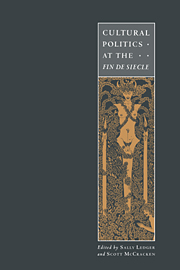Book contents
- Frontmatter
- Contents
- List of illustrations
- Notes on contributors
- Acknowledgements
- Introduction
- 1 The flight to the real
- 2 The New Woman and the crisis of Victorianism
- 3 Empire, ‘race’ and feminism at the fin de siècle: the work of George Egerton and Olive Schreiner
- 4 W. B. Yeats and Irish cultural politics in the 1890s
- 5 The double lives of man: narration and identification in late nineteenth-century representations of ec-centric masculinities
- 6 Henry James and the spectacle of loss: psychoanalytic metaphysics
- 7 ‘A very curious construction’: masculinity and the poetry of A. E. Housman and Oscar Wilde
- 8 The Pilgrims of Hope: William Morris and the dialectic of romanticism
- 9 Urban utopias: socialism, religion and the city, 1880 to 1900
- 10 Vampires and the empire: fears and fictions of the 1890s
- 11 Utopia, Limited: nationalism, empire and parody in the comic operas of Gilbert and Sullivan
- 12 Technologies of monstrosity: Bram Stoker's Dracula
- 13 Postmodernism, a Chance to reread?
- 14 Is market society the fin of history?
- Select bibliography
- Index
12 - Technologies of monstrosity: Bram Stoker's Dracula
Published online by Cambridge University Press: 29 September 2009
- Frontmatter
- Contents
- List of illustrations
- Notes on contributors
- Acknowledgements
- Introduction
- 1 The flight to the real
- 2 The New Woman and the crisis of Victorianism
- 3 Empire, ‘race’ and feminism at the fin de siècle: the work of George Egerton and Olive Schreiner
- 4 W. B. Yeats and Irish cultural politics in the 1890s
- 5 The double lives of man: narration and identification in late nineteenth-century representations of ec-centric masculinities
- 6 Henry James and the spectacle of loss: psychoanalytic metaphysics
- 7 ‘A very curious construction’: masculinity and the poetry of A. E. Housman and Oscar Wilde
- 8 The Pilgrims of Hope: William Morris and the dialectic of romanticism
- 9 Urban utopias: socialism, religion and the city, 1880 to 1900
- 10 Vampires and the empire: fears and fictions of the 1890s
- 11 Utopia, Limited: nationalism, empire and parody in the comic operas of Gilbert and Sullivan
- 12 Technologies of monstrosity: Bram Stoker's Dracula
- 13 Postmodernism, a Chance to reread?
- 14 Is market society the fin of history?
- Select bibliography
- Index
Summary
By way of an introduction to Bram Stoker's Dracula, I want to tell my own story about being consumed and drained by the vampire. Reading Dracula for the first time many years ago, I thought I noticed something about vampirism that had been strangely overlooked by critics and readers. Dracula, I thought, with his peculiar physique, his parasitical desires, his aversion to the cross and to all the trappings of Christianity, his blood-sucking attacks and his avaricious relation to money, resembled stereotypical anti-Semitic nineteenth-century representations of the Jew. Subsequent readings of the novel with attention to the connections in the narrative between blood and gold, ‘race’ and sex, sexuality and ethnicity, confirmed my sense that the anti-Semite's Jew and Stoker's vampire bore more than a family resemblance. The connection I had made began to haunt me; I uncovered biographical material and discovered that Stoker was good friends with, and inspired by, Richard Burton, the author of a tract reviving the blood libel against Jews in Damascus. I read essays by Stoker in which he railed against degenerate writers for not being good Christians. My conclusions seemed sound, the vampire and the Jew were related and monstrosity in the Gothic novel had much to do with the discourse of modern anti-Semitism.
- Type
- Chapter
- Information
- Cultural Politics at the Fin de Siècle , pp. 248 - 266Publisher: Cambridge University PressPrint publication year: 1995
- 2
- Cited by

